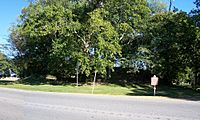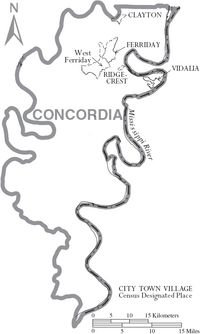Concordia Parish, Louisiana facts for kids
Quick facts for kids
Concordia Parish, Louisiana
|
|
|---|---|
| Parish of Concordia | |
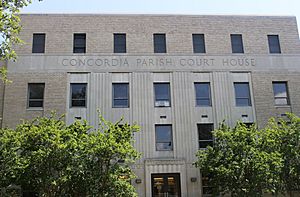
Old Concordia Parish Courthouse in Vidalia
|
|
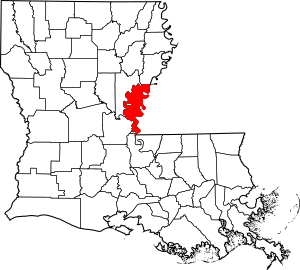
Location within the U.S. state of Louisiana
|
|
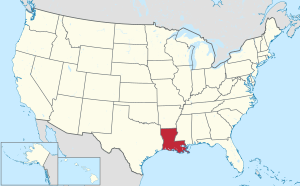
Louisiana's location within the U.S.
|
|
| Country | |
| State | |
| Region | Central |
| Founded | 1807 |
| Named for | Possibly a land grant, New Concordia |
| Parish seat (and largest city) | Vidalia |
| Area | |
| • Total | 1,930 km2 (747 sq mi) |
| • Land | 1,810 km2 (697 sq mi) |
| • Water | 100 km2 (50 sq mi) |
| • percentage | 17 km2 (6.7 sq mi) |
| Population
(2020)
|
|
| • Total | 18,687 |
| • Density | 9.659/km2 (25.016/sq mi) |
| Time zone | UTC-6 (CST) |
| • Summer (DST) | UTC-5 (CDT) |
| Area code | 318 |
| Congressional district | 5th |
Concordia Parish (Spanish: Parroquia de la Concordia; French: Paroisse de Concordia) is a parish that borders the Mississippi River in eastern central Louisiana. As of the 2020 census, the population was 18,687. The parish seat is Vidalia. The parish was formed in 1807.
Concordia Parish is part of the Natchez, MS–LA Micropolitan Statistical Area. It is historically considered part of the Natchez District, devoted to cotton cultivation as a commodity crop, in contrast to the sugar cane crop of southern Louisiana. Other Louisiana parishes of similar character are East and West Carroll, Madison and Tensas, all in this lowlying delta land. On the east side of the Mississippi River is the Natchez District around the city of Natchez, Mississippi.
Contents
History
Prehistory
Concordia Parish was the home to many successive Native American cultures for thousands of years before European encounter. Peoples of the Marksville culture, Troyville culture, Coles Creek culture and Plaquemine culture built villages and earthwork mound sites throughout the area. Notable examples include Cypress Grove Mound, DePrato Mounds, Frogmore Mound Site, and Lamarque Landing Mound.
Historic Native American tribes encountered by early French explorers and colonists were the following:
Historic era
Concordia was named by Anglo-American settlers for a Latin word meaning "harmony". They came mostly after the Louisiana Purchase of 1803, when the United States took over this formerly French colonial area west of the Mississippi. Like other parishes of the lands along the Mississippi River, in the antebellum era, the parish was developed for cotton cultivation on large plantations. The labor-intensive crop was profitable because of the labor of enslaved African Americans.
In 1789, Don Jose Vidal a resident of Natchez, MS and later the founder of the city of Vidalia, LA asked for land grants to move his family from Natchez to the other side of the Mississippi River. In Natchez, there was a mansion built called Concord (Natchez, Mississippi), this was a residence lived in by Spanish governors. Vidal moved his family across the Mississippi River to the Louisiana side after the time era of the US began.
The Mansion started the name "Concord" and ultimately later led to the birth of what would be Concordia Parish. During the year of 1804, a ceremony of transfer was held and the citizens and Mayor of Natchez crossed over to the Louisiana side of the Mississippi to honor the new land that was founded. The Mansion was later struck by fire in the early 20th century (1901) and burned down. Natchez people also lived on both sides of the land.
"Concordia County" was a creation of the first Legislative Council held in New Orleans on December 2, 1804. Its territory that included parts of the present parishes of East Carroll, Madison, and Tensas. Land between the Mississippi, Red, Black, and Tensaw rivers comprised the early local administration of Concordia.
Because Concordia's alluvial soil was unusually productive for cotton growing, it attracted large plantations, whose owners enslaved a very high number of people. In 1860, slaves made up 91 percent of Concordia Parish's residents, the highest percentage of any Louisiana parish. Only two counties in the United States — Washington and Issaquena counties in Mississippi — had a higher percentage of its population enslaved. As might be expected, the small number of white cotton planters in Concordia were fierce defenders of chattel slavery and strongly backed the Confederacy during the American Civil War.
Geography
According to the U.S. Census Bureau, the parish has a total area of 747 square miles (1,930 km2), of which 697 square miles (1,810 km2) is land and 50 square miles (130 km2) (6.7%) is water.
The parish is completely agricultural bottomlands. The Ouachita River runs along the west boundary, the Red River along the south, and the Mississippi River along the east. All three rivers are contained by large levee systems.
Major highways
Adjacent counties and parishes
- Tensas Parish (north)
- Adams County, Mississippi (northeast)
- Wilkinson County, Mississippi (east)
- West Feliciana Parish (southeast)
- Pointe Coupee Parish (south)
- Avoyelles Parish (southwest)
- Catahoula Parish (west)
National protected area
State protected area
- Richard K. Yancey Wildlife Management Area
Demographics
| Historical population | |||
|---|---|---|---|
| Census | Pop. | %± | |
| 1820 | 2,626 | — | |
| 1830 | 4,662 | 77.5% | |
| 1840 | 9,414 | 101.9% | |
| 1850 | 7,758 | −17.6% | |
| 1860 | 13,805 | 77.9% | |
| 1870 | 9,977 | −27.7% | |
| 1880 | 14,914 | 49.5% | |
| 1890 | 14,871 | −0.3% | |
| 1900 | 13,559 | −8.8% | |
| 1910 | 14,278 | 5.3% | |
| 1920 | 12,466 | −12.7% | |
| 1930 | 12,778 | 2.5% | |
| 1940 | 14,562 | 14.0% | |
| 1950 | 14,398 | −1.1% | |
| 1960 | 20,467 | 42.2% | |
| 1970 | 22,578 | 10.3% | |
| 1980 | 22,981 | 1.8% | |
| 1990 | 20,828 | −9.4% | |
| 2000 | 20,247 | −2.8% | |
| 2010 | 20,822 | 2.8% | |
| 2020 | 18,687 | −10.3% | |
| U.S. Decennial Census 1790-1960 1900-1990 1990-2000 2010 |
|||
2020 census
| Race | Number | Percentage |
|---|---|---|
| White (non-Hispanic) | 10,157 | 54.35% |
| Black or African American (non-Hispanic) | 7,477 | 40.01% |
| Native American | 39 | 0.21% |
| Asian | 115 | 0.62% |
| Other/Mixed | 440 | 2.35% |
| Hispanic or Latino | 459 | 2.46% |
As of the 2020 United States census, there were 18,687 people, 7,162 households, and 4,562 families residing in the parish.
Education
Concordia Parish School Board operates public schools in the parish.
Libraries
The Concordia Parish Library has 3 branches and a bookmobile service for all citizens of Concordia Parish.
- Ferriday Branch - 1609 Third Street, Ferriday, LA
- Vidalia Branch - 408 Texas Street, Vidalia, LA
- Clayton Branch - 31451 HWY-15 Clayton, LA
History
The Concordia Parish Library is the second oldest Parish Library in Louisiana and the first of such to be tax-supported. The library began as a movement between the President of the Tri-Parish Community Organization who had obtained a community program and a State Librarian at the time, Essae Martha Culver. The two held a dinner where they launched a library movement in Concordia Parish. The Ferriday Rotary Club and Police Jury along with the public worked with the Louisiana Library Commission on the project and in October 1928 the Concordia Parish Demonstration Library was opened. Citizens of the parish voted to implement a tax to ensure the library could continue to function after seeing the advantages provided by the library. The library moved in 1952 to its present-day main building site in Ferriday, Louisiana. In that same year the interested clubs of Ferriday and the Parish Library, The Concordia Parish Police Jury turned the Community Center over to the Concordia Parish Library to be operated as a parish library for all citizens of Concordia under the supervision of the Concordia Parish Library Board.
Library Cards
The library serves the citizens who reside in the boundaries of Concordia Parish. Any person permanently residing in Concordia Parish can use the services of a library with a library card. There are two types of library cards offered:
- Library Card: allows patrons to check out physical materials and use electronic services. This card requires two items of price of residents AND a photo identification. Card is issued without charge.
- Online Registration: allows access to Wi-Fi, public access, e-services, and downloadable databases.
National Guard
1086th Transportation Company of the 165th CSS (Combat Service Support) Battalion of the 139th RSG (Regional Support Group) is based in Vidalia, Louisiana on the west bank of the Mississippi River.
Communities
City
- Vidalia (parish seat and largest municipality)
Towns
Census-designated places
Other unincorporated communities
- Acme
- Ashland
- Black Hawk
- Dunbarton
- Eva
- Fairview
- Frogmore
- Mayna
- New Era
- West Ferriday
Notable people
Arts and entertainment
- Jerry Lee Lewis, musician
- Jimmy Swaggart, televangelist
- Mickey Gilley, musician
Journalism
- Campbell Brown, Emmy-award-winning journalist, CNN Anchor/host.
- Howard K. Smith, ABC and CBS commentator
See also
 In Spanish: Parroquia de Concordia para niños
In Spanish: Parroquia de Concordia para niños


